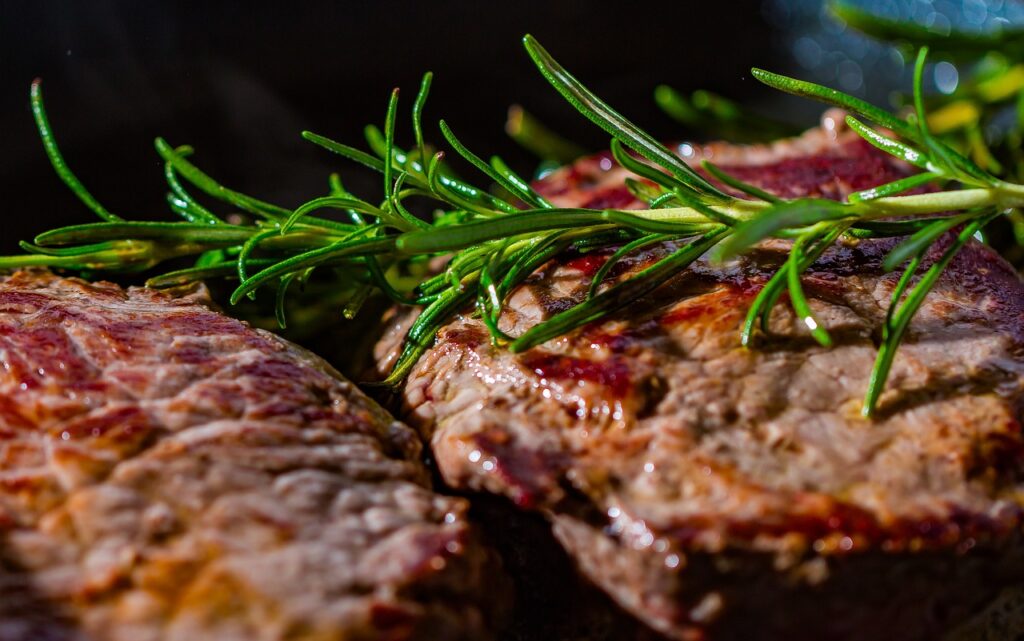The sizzle of a perfectly grilled steak paired with the golden, crispy perfection of frites – it’s a symphony for the senses that has captivated food lovers for decades. But what elevates this classic dish to new heights of flavor is the legendary Café de Paris sauce, a butter-based marvel that has tantalized taste buds since its inception in the bustling heart of Geneva, Switzerland. Let’s dive into the rich history and culinary prestige of this iconic sauce before we roll up our sleeves and create our own steak frites masterpiece at home.
The story of Café de Paris sauce
It begins in the 1930s, in the vibrant city of Geneva, at a restaurant that shares its name with the sauce itself. It was here, at the Café de Paris, that this culinary gem was born, thanks to the innovative spirit of Arthur-François (Freddy) Dumont. The sauce quickly became the talk of the town, and before long, it was the restaurant’s crowning glory, a speciality that drew in patrons from far and wide. The secret behind the sauce’s irresistible allure? It was whispered to be the brainchild of Mr. Dumont’s father-in-law, Mr. Boubier, a man whose culinary prowess was the stuff of legend.

As the years passed, the fame of the Café de Paris sauce spread beyond the Swiss borders, reaching the palates of gourmands across the globe. The sauce’s journey took it to the bustling streets of Paris, where it found a home in the Entrecôte groups of restaurants, operated by the descendants of Paul Gineste de Saurs. From the romantic avenues of Paris to the cosmopolitan corners of New York, from the sun-drenched boulevards of Dubai to the neon-lit nights of Hong Kong, the sauce became a symbol of gastronomic excellence.
What makes this sauce so popular worldwide
The truth is, both the Café de Paris and the Entrecôte restaurants guard their recipes as fiercely as a sommelier guards his finest vintage. Yet, thanks to the intrepid reporting of Le Monde, we have a glimpse into the complex tapestry of flavors that make up the Café de Paris sauce. Imagine a base of poultry livers, infused with the aromatic essence of fresh thyme and thyme flowers, blended with the richness of full cream and the tang of white Dijon mustard. This concoction is then emulsified with butter, water, and a delicate balance of salt and pepper to create a sauce that is as complex as it is delicious.
The preparation of this sauce is an art form in itself, a ballet of culinary techniques that begins with the browning of livers and thyme in one pan, while in another, cream is gently reduced with mustard and the subtle flavor of thyme flowers. The two are then married together, strained to silky perfection, and whipped into a frothy, tawny delight that, upon meeting the heat of a sizzling entrecôte, melts down to its natural creamy pea-soup-green hue. It’s a spectacle of taste and texture that has become the hallmark of the Café de Paris dining experience.
Not all that glitters is gold, and the London newspaper The Independent casts a shadow of doubt on the accuracy of Le Monde’s report. The proprietor of Le Relais de Venise – L’Entrecôte dismisses the claims, leaving us to wonder about the true composition of this culinary treasure. What we do know is that the sauce, when served at the Café de Paris, is a whipped froth that gracefully transforms into a liquid as it warms, while at the Entrecôte restaurants, it remains a creamy liquid from the start, less prone to separation and with a more subtle saltiness.
The Café de Paris butter offers a range of flavors
Beyond the sauce itself, there’s the Café de Paris butter, a compound butter that, while distinct from the classic sauce, carries the same name and an equally impressive array of flavors. This butter is a mosaic of herbs, spices, and condiments, from the piquancy of mustard and the freshness of marjoram to the earthiness of rosemary and the anise-like notes of tarragon. Add to that the smoky sweetness of paprika, the briny kick of capers, the sharpness of chives, and the umami depth of anchovies, and you have a butter that is as versatile as it is flavorful. Shaped into a log and chilled, it awaits its moment of glory atop a hot steak, melting into a sauce that is nothing short of divine.
As we prepare to embark on our own culinary adventure, creating a homemade steak frites with Café de Paris, let us take a moment to appreciate the journey of this extraordinary sauce. From its humble beginnings in a Swiss restaurant to its status as a global gastronomic icon, Café de Paris sauce has proven that, in the world of cuisine, a little butter can go a very long way. So, sharpen your knives, heat your grills, and get ready to savor a dish that is as rich in history as it is in flavor.
Now that we’ve delved into the fascinating history and the intricate flavors of Café de Paris sauce, it’s time to bring the bistro to your kitchen with a homemade Steak Frites with Café de Paris butter. This dish is a celebration of simplicity and flavor, a testament to the culinary magic that can happen when a few quality ingredients are prepared with care and passion. So, let’s get cooking and create a meal that will transport you to the heart of a Parisian bistro, right from the comfort of your own home.
Let’s talk steak. The entrecôte, or rib eye, is the traditional choice for this dish, known for its rich marbling and deep flavor. If you prefer a leaner cut, a sirloin steak will do just fine. The key is to choose a cut that you love and that will stand up to the bold flavors of the Café de Paris butter. Once you’ve selected your steak, let it come to room temperature before cooking – this ensures even cooking and a juicy result.
Onto the frites. These aren’t just any fries; they’re the crispy, golden counterparts to your succulent steak. For the best homemade frites, choose a starchy potato like Russets, which will give you that coveted crispy exterior and fluffy interior. Cut them into even sticks, and remember, the thinner they are, the crispier they’ll get. Soak them in cold water to remove excess starch, then dry them thoroughly before frying. A double-fry method – once at a lower temperature to cook through, and once at a higher temperature to crisp up – will give you restaurant-quality frites.
The Café de Paris butter. As we’ve learned, the original recipe is a closely guarded secret, but that doesn’t mean we can’t create our own version that’s just as delicious. Start with high-quality unsalted butter, and let it soften to room temperature. To this, you’ll add a finely tuned symphony of flavors: finely chopped eschalots, garlic, anchovy fillets, lemon juice, Worcestershire sauce, Dijon mustard, curry powder, paprika, kosher salt, tarragon, and parsley. Each ingredient plays a role in building the complex flavor profile that makes Café de Paris butter so extraordinary.
Mixing the butter is an exercise in patience and precision. You want to ensure that all the ingredients are thoroughly combined, creating a harmonious blend. Once mixed, shape the butter into a log using cling wrap, twisting the ends tightly to form a neat roll. Chill it in the refrigerator until it’s firm enough to slice. This compound butter can be made in advance and stored in the fridge or freezer, ready to be sliced and melted over your perfectly cooked steak.
When it’s time to serve, cook your steak to your preferred doneness, seasoned simply with salt and pepper to let the flavors of the meat and the butter shine. As the steak rests, fry your frites to crispy perfection. Plate up by placing the steak on a warm plate, topped with slices of the Café de Paris butter, allowing it to melt and mingle with the meat’s juices. Add a generous helping of frites on the side, and voilà – you have a homemade Steak Frites with Café de Paris that’s sure to impress.
As you savor each bite, let the flavors take you on a journey – from the rich history of the Café de Paris in Geneva to the bustling streets of Paris where the sauce found its fame. This dish is more than just a meal; it’s a culinary experience that celebrates the art of cooking and the joy of eating. So, raise a glass to tradition, to innovation, and to the simple pleasure of a dish well made. Bon appétit!
Creating the perfect homemade Steak Frites with Café de Paris is about embracing the essence of French cuisine – quality ingredients, careful preparation, and a touch of culinary flair. Whether you’re a seasoned chef or a home cook looking to try something new, this dish is a testament to the fact that some of the best meals are those made with love and a little bit of butter. So, go ahead, give it a try, and let the flavors of Café de Paris butter transform your steak into a masterpiece of home cooking.
Related posts:
Café de Paris sauce
Café de Paris butter – sauce for steak
How to make the Famous L’Entrecote Steak Sauce





